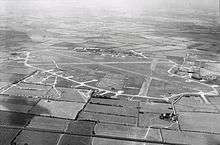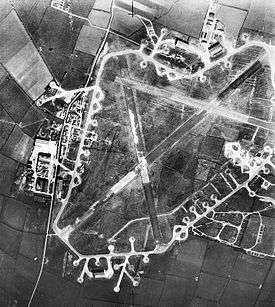RAF Langar
| RAF Langar USAAF Station AAF-490 RCAF Langar   | |||||||||||||||
|---|---|---|---|---|---|---|---|---|---|---|---|---|---|---|---|
|
Aerial photograph of RAF Langar airfield, the control tower and technical site are at the left, the bomb dump is to the right, 17 April 1945 | |||||||||||||||
 Low oblique photo of Langar airfield, September 1943 looking to the northwest. Noticing the large number of C-47s and Gliders on the grass parts of the field along with the hardstands. | |||||||||||||||
| IATA: none – ICAO: none | |||||||||||||||
| Summary | |||||||||||||||
| Airport type | Military | ||||||||||||||
| Owner | Air Ministry | ||||||||||||||
| Operator |
Royal Air Force United States Army Air Forces Royal Canadian Air Force | ||||||||||||||
| Location | Langar, Nottinghamshire | ||||||||||||||
| Built | 1942 | ||||||||||||||
| In use | 1942-1963 | ||||||||||||||
| Elevation AMSL | 121 ft / 37 m | ||||||||||||||
| Coordinates | 52°53′30″N 000°54′07″W / 52.89167°N 0.90194°WCoordinates: 52°53′30″N 000°54′07″W / 52.89167°N 0.90194°W | ||||||||||||||
| Map | |||||||||||||||
 RAF Langar Location in Nottinghamshire | |||||||||||||||
| Runways | |||||||||||||||
| |||||||||||||||
Royal Air Force Station Langar or more simply RAF Langar is a former Royal Air Force station located near the village of Langar, Nottinghamshire, England. The airfield is located approximately 6 miles (9.7 km) east-southeast of Radcliffe on Trent and about 100 miles (160 km) north-northwest of London, England.
Opened in 1942 during World War II, it was used by both the Royal Air Force and United States Army Air Forces. During the war it was used primarily as troop carrier transport airfield. After the war it was provided to the Royal Canadian Air Force which used it as an operational base until 1963.
Today the airfield is the location for the British Parachute Schools, who use the original control tower for their headquarters. The former Avro industrial complex is used by private industry.
History
RAF Bomber Command use
The first flying unit arrived in September 1942 when No. 207 Squadron arrived with Lancaster bombers from RAF Bottesford.[1] 207 Squadron was a major RAF Bomber Command unit and participated in major raids on occupied Europe.
Also, in September 1942, A.V. Roe Ltd. prepared to use a large hangar complex on the west side of the Langar/Harby road to carry out major repair and maintenance of Lancasters.
The squadron remained until October 1943 when it moved to RAF Spilsby.[1]
USAAF use
In November 1943 Langar was transferred to the USAAF Ninth Air Force as a troop carrier group base. Langar was known as USAAF Station AAF-490 for security reasons by the USAAF during the war, and by which it was referred to instead of location. Its USAAF Station Code was "LA".
435th Troop Carrier Group
The 435th Troop Carrier Group arrived at Langar on 3 November 1943 from Baer AAF Indiana with four squadrons of 56 C-47s. Operational squadrons of the group were:
- 75th Troop Carrier Squadron (SH)
- 76th Troop Carrier Squadron (CW)
- 77th Troop Carrier Squadron (IB)
- 78th Troop Carrier Squadron (CM)
The 435th TCW was assigned to the 53rd Troop Carrier Wing.
The group began operational training at the airfield, however it was moved on 25 January 1944 to RAF Welford to train alongside the 101st Airborne Division.
438th Troop Carrier Group
Langar remained vacant for about a month until the 438th Troop Carrier Group arrived in early February 1944 from Baer AAF, Indiana. Operational squadrons of the group were:
- 87th Troop Carrier Squadron (3X)
- 88th Troop Carrier Squadron (M2)
- 89th Troop Carrier Squadron (4U)
- 90th Troop Carrier Squadron (Q7)
The 438th TCW was assigned to the 53rd Troop Carrier Wing. Like its predecessor, the group was moved south after a month to a new station at RAF Greenham Common.
441st Troop Carrier Group
The 441st Troop Carrier Group arrived at Langar on 17 March Baer AAF Indiana with four squadrons of 56 C-47s. Those being:
- 99th Troop Carrier Squadron (3J)
- 100th Troop Carrier Squadron (8C)
- 301st Troop Carrier Squadron (Z4)
- 302d Troop Carrier Squadron (2L)
The 441st was a group of Ninth Air Force's 50th Troop Carrier Wing, IX Troop Carrier Command. It was scheduled to be assigned to Langar, however it only remained until 25 April until being moved to RAF Merryfield.
In August 1944 Langar was returned to RAF control for operational use.
Post D-Day use
In October 1944, RAF Bomber Command returned to Langar moving in with No. 1669 Heavy Conversion Unit with 32 Lancasters which used the station until March 1945. Although retained by the Ministry of Defence. The airfield was used after the war for a short time for prisoners of war and then for displaced persons.
Early in 1952 it was taken over by the Royal Canadian Air Force (RCAF) to become a supply station for the Canadian NATO squadrons. The airfield was constructed on the old domestic and technical sites with completely new buildings, to a much higher standard than the Air Ministry was used to, by an English design team led by architect Peter Benton, under the direction of an RCAF officer. For 12 months nearly 1000 men worked constructing the station, which worked around two two acre warehouses. another was added later and is now in private ownership. The first RCAF personnel arrived autumn 1952.
The airfield was used for eleven years (1952–1963) as 30 Air Materiel Base, RCAF Langar. Langar was the RCAF's primary supply station for No. 1 Air Division RCAF in Europe, a complex of four fighter bases set up in nearby RAF North Luffenham and in France and West Germany by Canada to help meet NATO's European air defence commitments during the Cold War. It was the only Canadian airfield in the UK.
The RCAF established No. 30 Air Materiel Base (AMB), to handle the transportation of supplies, equipment, aircraft, personnel, and other support essential for the operation of the four NATO air bases and its headquarters. Several units were attached to 30 AMB; No. 137 (Transport) Flight, which was attached to the Movements Unit of 30 AMB, operated several types of aircraft including six Bristol Freighters, one Beechcraft Expeditor, and two Dakotas. No. 312 Supply Depot handled medical supplies and spares for mechanical equipment, including aircraft (e.g. the F-86 Sabre) and vehicles. No. 314 Technical Services Unit was tasked with inspecting all supplies before they were forwarded to operational bases. This unit also assisted with repair contracts and provided technical advice.
The final use of the station by the Canadian Forces was in May 1995 on the 50th anniversary year of VE-Day. During the commemoration, a small team of Canadian military parachutists arrived from Holland--where they had conducted parachute activities during the 'Thank you Canada' liberation celebrations. They joined a larger group of American airborne veterans at the British Parachute Schools at Langar, Nottinghamshire. In the days before, the Americans and Canadians had undergone some conversion training at the No.1 Parachute Training School at Royal Air Force Brize Norton. However, inclement weather and other factors prevented the group from jumping onto the Weston-on-the-Green drop zone. Following a quick refresher course fittingly conducted by a former 'Red Devil' who was the school's chief parachute jumping instructor, the paratroopers embarked on the twin engine Britten Norman aircraft and a giant biplane--the Antonov AN-2 Colt. Despite marginal weather and high winds, the mass parachute drop was made without casualties onto the airfield using round G-Q military type parachutes. The para drop afforded these Canadians the only opportunity to jump in the UK, but more importantly, it provided a fitting venue from which to pay tribute to the memory of all the Canadians who fought from bases in Britain during the Second World War. A pipe band led the parade off the drop zone to the wreath laying ceremony at the airfield's RAF memorial. A reception was given by the Lord Mayor Peter Burgess at the Nottinghamshire County Council Hall in West Bridgford. Lieutenant Colonel C.A. Kiernan, MBE: a war Veteran (1942 to 1965) of the Parachute Regiment, and local members of the UK Territorial Army's 144 Parachute Medical Squadron, attended to mark the occasion.
Current use
With the facility released from military control in 1963, the airfield (now called Langar Airfield) is the base for the British Parachute Schools, who use the original control tower for their headquarters. The former Avro industrial complex is used by private industry. There is a go-karting track.
The airfield is relatively intact, with most of its wartime facilities still in use. The main runway (01/19) and NE/SW secondary (07/25) are still active and in use. The original technical site is still in use, along with both wartime T-2 hangars. Additional postwar hangars and a secondary maintenance site built to the northwest, along with many of the loop dispersal hardstands around the wartime perimeter track still exist.
See also
References
![]() This article incorporates public domain material from the Air Force Historical Research Agency website http://www.afhra.af.mil/.
This article incorporates public domain material from the Air Force Historical Research Agency website http://www.afhra.af.mil/.
Citations
- 1 2 Jefford 1988, p. 69.
Bibliography
- Freeman, Roger A. (1994) UK Airfields of the Ninth: Then and Now. After the Battle ISBN 0-900913-80-0
- Jefford, C.G, MBE,BA ,RAF (Retd). RAF Squadrons, a Comprehensive Record of the Movement and Equipment of all RAF Squadrons and their Antecedents since 1912. Shrewsbury, Shropshire, UK: Airlife Publishing, 1988. ISBN 1-84037-141-2.
- Maurer, Maurer (1983). Air Force Combat Units Of World War II. Maxwell AFB, Alabama: Office of Air Force History. ISBN 0-89201-092-4.
- British Automobile Association (AA), (1978), Complete Atlas of Britain, ISBN 0-86145-005-1
- www.controltowers.co.uk RAF Langar
External links
| Wikimedia Commons has media related to RAF Langar. |
- Photographs of RAF Langar from the Geograph British Isles project
- Aerial photo of RAF Langar from Multimap.com
- RAF Langar from RAF Bomber Command History site
- Crews of Lancasters EM-N and EM-V of 207 Squadron, kia 28 August 1943
- 207 Squadron Association website
- WikiMapia
Video clips
- Skydive in June 2008 by Archbishop John Sentamu
- Skydiving
- 2007 skydive
- 2006 skydive


.svg.png)